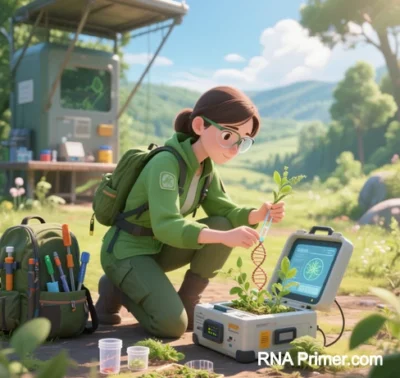
RNA vs. DNA Primers: Complementary Drivers of Molecular Biology
As core tools for genetic information transfer and engineering, RNA and DNA primers exhibit complementary molecular mechanisms and applications. Their distinct properties underpin technologies spanning DNA replication to advanced gene editing. Below, we dissect their differences, selection logic, and transformative impacts.
I. Molecular Differences: From Chemistry to Functional Boundaries
| Property | RNA Primers | DNA Primers | Biological Significance |
|---|---|---|---|
| Chemical Composition | Ribonucleotides (uracil, 2′-OH group) | Deoxyribonucleotides (thymine, 2′-H group) | 2′-OH in RNA increases hydrolysis sensitivity, limiting thermal stability. |
| Synthesis | Enzymatically synthesized by primase | Chemically synthesized (phosphoramidite) | RNA primers are irreplaceable in natural DNA replication. |
| Structure | Single-stranded (8-12 nt) | Paired forward/reverse strands (18-24 nt) | DNA primer pairing enables PCR specificity. |
| Modifications | Native 3′-OH terminus | Customizable (e.g., fluorescent tags, phosphorothioates) | DNA programmability drives NGS and probe development. |
| Stability | Short half-life (RNase-sensitive) | Long-term storage (-20°C for years) | DNA stability supports industrial assay kits. |
Case Study: Telomerase uses its RNA component as a primer template to solve chromosome end-shortening via reverse transcription, leveraging RNA’s transient nature to avoid genomic instability.
II. Selection Logic: From Cellular Contexts to Industrial Applications
- Why Evolution Favors RNA Primers In Vivo
- Enzymatic Constraints: DNA polymerase III cannot initiate synthesis without RNA primers providing 3′-OH.
- Error Correction: RNase H/FEN1 excises RNA primers, replaced by DNA to ensure replication fidelity (error rate ~10⁻¹⁰).
- Energy Efficiency: Primase consumes less ATP than full DNA synthesis, aligning with cellular metabolism.
- DNA Primers Dominate In Vitro Engineering
| Selection Factor | Technical Rationale | Applications |
|———————-|——————————————–|——————————————–|
| Thermal Stability | Withstands 95°C denaturation (PCR requirement) | COVID-19 diagnostic kits |
| Sequence Control | Single-base precision (e.g., restriction sites) | Golden Gate DNA assembly |
| Functional Versatility | 5′-end modifications (e.g., TaqMan probes) | Real-time qPCR, digital PCR |
| Cost Efficiency | Bulk synthesis ($0.1/nt for large orders) | Whole-genome sequencing primer pools |
Breakthrough: RNA-primed PCR leverages rTth polymerase’s reverse transcriptase activity to amplify unknown sequences (30% efficiency of standard PCR), enabling ancient DNA repair and metagenomic analysis.
III. Transformative Impacts in Genetic Technology
- Foundational Discoveries
- Replication Fork Dynamics: RNA primer spatiotemporal mapping revealed leading/lagging strand synthesis, advancing eukaryotic chromosome studies.
- Telomeres & Aging: RNA primer-mediated telomere extension mechanisms inspired telomerase inhibitors for cancer/anti-aging therapies.
- Diagnostic Technology Evolution
| Generation | Primer Type | Sensitivity | Landmark Products |
|——————-|————————–|———————–|—————————————|
| 1st-Gen PCR | DNA primers | 10³ copies/μL | HIV viral load tests |
| Digital PCR | Locked nucleic acid (LNA) primers | 1 copy/μL | EGFR T790M liquid biopsy for lung cancer |
| CRISPR-Dx | sgRNA primers | 0.1 copy/μL | SHERLOCK Zika virus detection | - Synthetic Biology Innovations
- Self-Cleaving Primers: Ribozyme-integrated RNA primers auto-remove post-CRISPR editing, reducing off-target risks (Nature Biotech, 2024).
- Light-Activated Primers: Azobenzene-modified RNA primers enable spatiotemporal DNA repair in neurons.
- Industrial Milestones
- China’s RiboBio developed GalNAc-siRNA delivery with liver-targeted DNA primers, cutting production costs by 80%.
- Illumina NovaSeq X uses DNA/RNA hybrid primers to achieve 200 Gb per sequencing run.
IV. Future Challenges & Interdisciplinary Synergy
| Frontier | Technical Challenge | Solution | Potential Impact |
|---|---|---|---|
| Primer-Carrier Co-Delivery | Short RNA primer half-life in vivo | LNPs with thiophosphate-modified primers | Enhanced organ-targeted gene editing |
| AI-Driven Design | Complex secondary structure prediction | Graph neural networks (DeepPrimer 2.0) | Primer development from 2 weeks to 4 hours |
| Environment-Responsive Primers | Low microenvironment specificity | pH/ROS-sensitive DNA primer switches | Tumor-specific drug activation |
| Quantum Computing | Inaccurate nucleic acid binding simulations | IBM quantum chips optimize Tm prediction | Design error <0.3°C |
Ethical Debate: Self-replicating RNA primer systems risk biosecurity breaches, necessitating global regulatory frameworks.
Conclusion
The interplay between RNA and DNA primers reflects nature’s evolutionary logic and human technological ingenuity. Together, they drive:
- Scientific Advancement: From chemical bond analysis to epigenetic networks.
- Technological Revolution: Single-molecule detection and synthetic genome engineering.
- Industry Transformation: Transition from “kit-based” models to “genetic AI agent” ecosystems.
Chinese innovations in CRISPR guide RNA (e.g., He Jiankui’s Base Editor) and nucleic acid delivery (e.g., RiboBio’s STP705) are reshaping global biotech competition. Over the next decade, primer engineering will converge with AI and quantum computing to enable “molecular scalpel” precision medicine.
Data sourced from public references. For collaboration or domain inquiries, contact: chuanchuan810@gmail.com





